
Kohlrabi, also called German turnip or turnip cabbage, is a biennial vegetable, a low, stout cultivar of wild cabbage. It is a cultivar of the same species as cabbage, broccoli, cauliflower, kale, Brussels sprouts, collard greens, Savoy cabbage, and gai lan.

The turnip or white turnip is a root vegetable commonly grown in temperate climates worldwide for its white, fleshy taproot. Small, tender varieties are grown for human consumption, while larger varieties are grown as feed for livestock. The name turnip – used in many regions – may also include rutabaga, neep or swede.

Cabbage, comprising several cultivars of Brassica oleracea, is a leafy green, red (purple), or white biennial plant grown as an annual vegetable crop for its dense-leaved heads. It is descended from the wild cabbage, and belongs to the "cole crops" or brassicas, meaning it is closely related to broccoli and cauliflower ; Brussels sprouts ; and Savoy cabbage.

Broccoli is an edible green plant in the cabbage family whose large flowering head, stalk and small associated leaves are eaten as a vegetable. Broccoli is classified in the Italica cultivar group of the species Brassica oleracea. Broccoli has large flower heads, or florets, usually dark green, arranged in a tree-like structure branching out from a thick stalk, which is usually light green. The mass of flower heads is surrounded by leaves. Broccoli resembles cauliflower, which is a different but closely related cultivar group of the same Brassica species.
A pH indicator is a halochromic chemical compound added in small amounts to a solution so the pH (acidity or basicity) of the solution can be determined visually or spectroscopically by changes in absorption and/or emission properties. Hence, a pH indicator is a chemical detector for hydronium ions (H3O+) or hydrogen ions (H+) in the Arrhenius model.
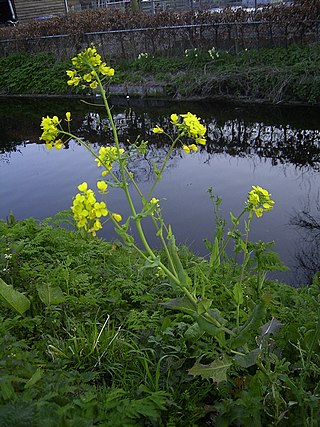
Brassica is a genus of plants in the cabbage and mustard family (Brassicaceae). The members of the genus are informally known as cruciferous vegetables, cabbages, mustard plants, or simply brassicas. Crops from this genus are sometimes called cole crops—derived from the Latin caulis, denoting the stem or stalk of a plant.

Cauliflower is one of several vegetables cultivated from the species Brassica oleracea in the genus Brassica, which is in the Brassicaceae family.

The raspberry is the edible fruit of a multitude of plant species in the genus Rubus of the rose family, most of which are in the subgenus Idaeobatus. The name also applies to these plants themselves. Raspberries are perennial with woody stems.

The Brussels sprout is a member of the Gemmifera cultivar group of cabbages, grown for its edible buds.

Plant nutrition is the study of the chemical elements and compounds necessary for plant growth and reproduction, plant metabolism and their external supply. In its absence the plant is unable to complete a normal life cycle, or that the element is part of some essential plant constituent or metabolite. This is in accordance with Justus von Liebig's law of the minimum. The total essential plant nutrients include seventeen different elements: carbon, oxygen and hydrogen which are absorbed from the air, whereas other nutrients including nitrogen are typically obtained from the soil.
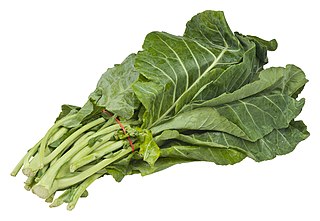
Collard is a group of loose-leafed cultivars of Brassica oleracea, the same species as many common vegetables including cabbage and broccoli. Part of the Acephala (kale) cultivar group, it is also classified as the variety B. oleracea var. viridis.

Kale, also called leaf cabbage, belongs to a group of cabbage cultivars primarily grown for their edible leaves. It has also been used as an ornamental plant.
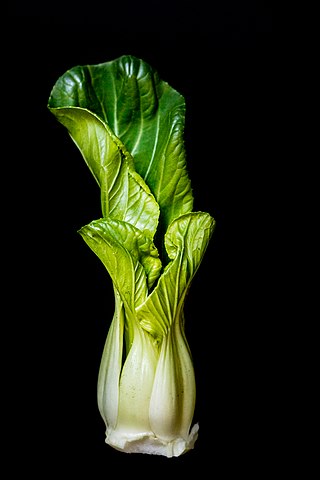
Bok choy, pak choi or pok choi is a type of Chinese cabbage, used as food. Chinensis varieties do not form heads and have green leaf blades with lighter bulbous bottoms instead, forming a cluster reminiscent of mustard greens. It has a flavor between spinach and water chestnuts but is slightly sweeter, with a mildly peppery undertone. The green leaves have a stronger flavor than the white bulb.
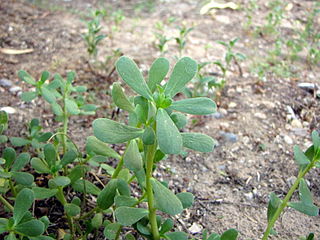
Portulaca oleracea is an annual succulent in the family Portulacaceae.

Brassica oleracea is a plant species from family Brassicaceae that includes many common cultivars used as vegetables, such as cabbage, broccoli, cauliflower, kale, Brussels sprouts, collard greens, Savoy cabbage, kohlrabi, and gai lan.

Brassica juncea, commonly brown mustard, Chinese mustard, Indian mustard, leaf mustard, Oriental mustard and vegetable mustard, is a species of mustard plant.

Savoy cabbage is a variety of the plant species Brassica oleracea. Savoy cabbage is a winter vegetable and one of several cabbage varieties. It has crinkled, emerald green leaves, which are crunchy with a slightly elastic consistency on the palate.
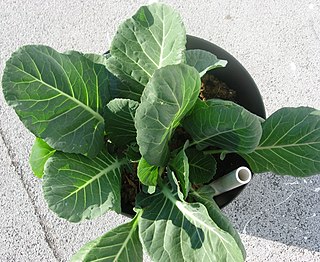
The acephala group refers to any type of Brassica which grows without the central 'head' typical of many varieties of cabbage. These are included within the species Brassica oleracea, such as kale. The name literally means "without a head" in contrast to those varieties known as capitata or "with a head". This group includes a number of species, both wild and cultivated, many of which are grown for their edible leaves and flowers.

Rocket, eruca, or arugula is an edible annual plant in the family Brassicaceae used as a leaf vegetable for its fresh, tart, bitter, and peppery flavor. Its other common names include "garden rocket", as well as "colewort", "roquette", "ruchetta", "rucola", "rucoli", and "rugula". E. vesicaria is widely popular as a salad vegetable and is native to the Mediterranean region.
The Future 50 Foods report, subtitled "50 foods for healthier people and a healthier planet", was published in February 2019 by the World Wide Fund for Nature (WWF) and Knorr. It identifies 50 plant-based foods that can increase dietary nutritional value and reduce environmental impacts of the food supply, promoting sustainable global food systems.
























